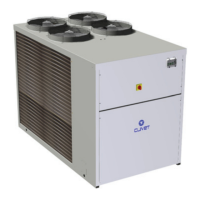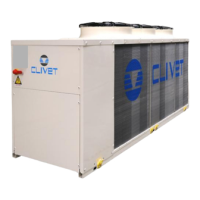44
8 - MAINTENANCE
8.6 ELECTRIC FANS 8.1 GENERAL
Maintenance must be done by authorized centres or by
qualified personnel
The maintenance allows to:
maintain the unit efficiency
reduce the deterioration speed to whom every equipment
is subject over time
assemble information and data to understand the state of
the unit efficiency and avoid possible damages
8.8 WATER EXCHANGER
Check :
the fans and the relative protection gridsare well fixed
The fan bearings (evident by noise and anomalous
vibrations )
the terminal protection covers are closed and the cable
holders are properly positioned
The inspections should be carried out at least:
Every year for only the cooling units
Every six months for the cooling and warming units
The frequency, however, depends on the use.
In the event of frequent use it is recommended to plan
inspections at close intervals:
frequent use (continuous or very intermittent use, near
the operating limits, etc)
critical use (service necessary).
8.2 INSPECTIONS FREQUENCY
8.3 UNIT BOOKLET
It’s advisable to create a unit booklet to take notes of the unit
interventions.
In this way it will be easier to adequately note the various
interventions and aid any troubleshooting.
Report on the booklet:
data
type of intervention effected
intervention description
carried out measures etc.
8.5 WATER FILTER
Check that no impurities prevent the correct passage of water.
It is very important for the exchanger to be able to provide the
maximum thermal exchange. Therefore, it is essential for the
inner surfaces to be clean of dirt and incrustations.
Periodically check the difference between the temperature of
the supply water and the condensation temperature. If the
difference is greater than 8 °C – 10 ° C it is advisable to clean
the exchanger.
The clearing must be effected :
With circulation opposite to the usual one
With a speed at least 1,5 times higher than the nominal one
With an appropriate product moderately acid (95% water +
5% phosphoric acid
After the cleaning rince with water to inhibe the detergent
rests.
Check the condition of the parts making up the structure.
Paint so as to eliminate or reduce oxidation at the points in the
unit where this problem may occur.
Check that the panelling is fastened correctly.
Poor fastening may give rise to malfunctions and abnormal
noise and vibration.
8.4 STRUCTURE
8.7 COIL
Contact with the exchanger fins can cause cuts.
Wear protective gloves to perform the above described
operations.
It is extremely important that the battery gives the maximum
thermal exchange; therefore, its surface must be cleaned from
dust and deposits. Remove all impurities from the surface.
Using an air pressure gun, clean the aluminum surface of the
battery. Be careful to direct the air in the opposite direction of
the fan air movement.
Hold the gun parallel to the fins to avoid damages. As an
alternative, an aspirator can be used to suck impurities from
the air input side.
Verify that the aluminum fins are not bent or damaged. In the
event of damages, contact the authorized assistance center
and get the battery “ironed out” in order to restore the initial
condition for an optimal air flow
TENSIONS
After switching off the power, wait at least 5 minutes before
accessing to the electrical panel or any other electrical
component.
Check with a multimeter that there are no residual tensions

